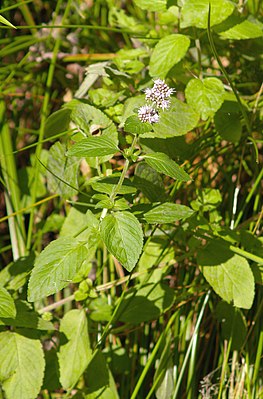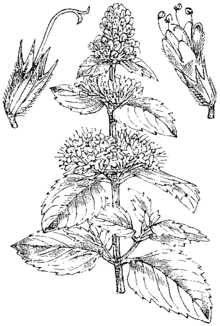Water mint
| Water mint | ||||||||||||
|---|---|---|---|---|---|---|---|---|---|---|---|---|

Water mint ( Mentha aquatica ), habit, leaves and inflorescence |
||||||||||||
| Systematics | ||||||||||||
|
||||||||||||
| Scientific name | ||||||||||||
| Mentha aquatica | ||||||||||||
| L. |
The water mint ( Mentha aquatica ), also Bach mint called, is a plant kind in the family of the mint (Lamiaceae). It occurs in large areas of Europe.
description
Appearance and foliage leaf
The water mint grows as a perennial herbaceous plant that usually reaches heights of 20 to 50 (10 to 100) centimeters. Subterranean runners are formed on land and aboveground in the water. The upright and mostly branched stem is square.
The against-constantly arranged on the stem leaves are long stalks. The simple leaf blade is ovate, elliptical, somewhat coarse and often shiny, with a serrated leaf margin . There are four to six pairs of arched pinnate nerves. The leaves in particular smell of peppermint when rubbed.
Inflorescence, flower and fruit
The flowers stand close together in the axils of the upper leaves in standing, loosely arranged pseudo whorls and in a terminal spherical, cephalic partial inflorescence .
The flowers are zygomorphic and five-fold with a double flower envelope . The five somewhat unequal sepals are partially fused together with 13 nerves and five lanceolate calyx teeth. The five light purple, pink, fleshy pink to white petals are fused to different degrees and only weakly two-lipped. The upper lip is usually the size of one of the three lobes of the lower lip. As a result, the flower almost regularly appears to have four columns. Of the four straight, fertile stamens , two are slightly longer.
The Klausen fruits disintegrate into four warty partial fruits.
Chromosome number
The number of chromosomes is 2n = 96.
ecology
The water mint is a hemicryptophyte (stem plant) or a swamp plant and a runners creeping pioneer. The leaves contain plenty of essential oils .
The flowers are inconspicuous "small funnel flowers". The nectar is secreted by a large nectar gland at the base of the flower and protected by the long inner hairs of the corolla ("sap layer"). The plant is usually incompletely dioecious ( gyno- dioecious ), i. H. In addition to hermaphrodite plants, there are also female plants with smaller flowers (as with all species of the mint genus ). The flowers are fragrant and are therefore visited intensively by various insects , for example bees , hover flies and many other species.
The seeds spread through the water ( hydrochory ).
As with all mint species, vegetative reproduction occurs through aboveground and underground runners .
Occurrence
Water mint can be found in large parts of Europe and Africa. It is also widespread in Macaronesia , Cyprus , Lebanon , Israel , Palestine , Turkey , the Caucasus and Iran .
The water mint often thrives in reed beds and large sedge communities, on banks and ditches, in wet and bog meadows, in swamp forests and in willow bushes. It prefers to grow in slightly acidic, muddy soil . According to Ellenberg , it is a half-light plant, a moderate heat pointer, a wet pointer, a weak acid to weak base pointer. It grows in moderately nitrogenous locations. According to Oberdorfer, it is an order character of the still water reed beds in fresh water ( Phragmitetalia ). But it also occurs in societies of the Filipendulion, Alnion or Salicion cinereae associations. In the Allgäu Alps, it hardly rises to an altitude of 1000 meters.
History as a medicinal plant
The water mint counted in addition to the Real meadowsweet ( Filipendula ulmaria ) and the verbena ( Verbena officinalis ) to the sacred herbs of the Druids . In the Middle Ages and early modern times, water mint was used, among other things, against the " stitch ". The botanical name Menta aquatica also appeared in Eucharius Rößlin in the 16th century .
Systematics
The first publication of Mentha aquatica was made in 1753 by Carl Linnaeus in Species Plantarum , 2, S. 576. synonyms for Mentha aquatica L. are among many others Mentha acute Opiz , Mentha acutata Opiz , Mentha acute Strail , Mentha hirsuta Huds. , Mentha palustris Mill. , Mentha dumetorum var. Natalensis Briq. , Mentha braunii Oborný , Mentha capitata Opiz , Mentha ortmanniana Opiz , Mentha riparia Schreb. , Mentha aquatica subsp. caput-medusae Trautm. & Urum. , Mentha aquatica subsp. Ortmanniana (Opiz) Lemke .
One can distinguish between two subspecies:
- Mentha aquatica L. subsp. aquatica
- Mentha aquatica subsp. litoralis Hartm. (Syn .: Mentha litoralis (Hartm.) Neuman )
The hybrid peppermint ( Mentha × piperita ), which has a more pleasant smell and taste than its parents, emerged from a cross between the water mint ( Mentha aquatica ) and the green mint ( Mentha spicata ) in a medicinal garden in England in 1696 .
The whorl mint ( Mentha × verticillata ) is a cross between the field mint ( Mentha arvensis ) and the water mint. It lies between its two parents in all characteristics, is often a little stronger and can then suppress them.
literature
- Johann Christoph Röhling, Franz Carl Mertens & Wilhelm Daniel Joseph Koch: Germany's Flora , Volume 4, Wilmans, 1833. Google Books Online. : Mentha aquatica on page 552.
Individual evidence
- ^ Hermann Fischer: Mittelalterliche Pflanzenkunde , Munich 1929 (= history of science: history of botany, 2), reprint, with a foreword by Johannes Steudel, Hildesheim 1967, p. 275.
- ↑ a b c Erich Oberdorfer : Plant-sociological excursion flora for Germany and neighboring areas . With the collaboration of Angelika Schwabe and Theo Müller. 8th, heavily revised and expanded edition. Eugen Ulmer, Stuttgart (Hohenheim) 2001, ISBN 3-8001-3131-5 , pp. 817 .
- ↑ Jelitto / Schacht / Simon: Die Freilandschmuckstauden , p. 610 ff., Verlag Eugen Ulmer & Co., 5th edition 2002. ISBN 3-8001-3265-6
- ↑ Rafaël Govaerts (ed.): Mentha aquatica. In: World Checklist of Selected Plant Families (WCSP) - The Board of Trustees of the Royal Botanic Gardens, Kew . Retrieved January 10, 2018.
- ↑ Erhard Dörr, Wolfgang Lippert : Flora of the Allgäu and its surroundings. Volume 2, IHW, Eching 2004, ISBN 3-930167-61-1 , p. 414.
- ↑ Eucharius Roesslin: Der Swangern frawen und hebammen Roßgarten , Worms 1513, Neudruck Berlin undated , O II recto
- ↑ Mentha aquatica at Tropicos.org. Missouri Botanical Garden, St. Louis
- ↑ Euro + Med Plantbase Project : Mentha aquatica
Web links
- Water mint. In: FloraWeb.de.
- Water mint . In: BiolFlor, the database of biological-ecological characteristics of the flora of Germany.
- Mentha aquatica L. In: Info Flora , the national data and information center for Swiss flora . Retrieved February 27, 2016.
- Distribution in the northern hemisphere
- Thomas Meyer: Mint data sheet with identification key and photos at Flora-de: Flora von Deutschland (old name of the website: Flowers in Swabia )
- Entry in Plants for A Future.
- Data sheet from Wild Flowers of Ireland .
- Picsearch: Mentha aquatica
- Picsearch: Mentha citrata




